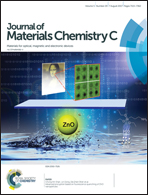A new n-type semiconducting molecule with an asymmetric indenothiophene core for a high-performing non-fullerene type organic solar cell†
Abstract
Herein, a new asymmetric n-type semiconducting molecule (PhITBD) with an indenothiophene core was designed, synthesized using tethering 2-(benzo[c][1,2,5]-thiadiazol-4-ylmethylene)-malononitrile (BM) as terminal groups, and applied to polymer solar cells (PSCs). The PSCs with asymmetric PhITBD displayed improved power conversion efficiencies (PCE) of 6.57% as compared to those with the symmetric molecule IDT-2BM. The higher PCE value of the PhITBD-based PSC was mainly attributed to the enhanced photovoltaic properties, the Voc, Jsc, FF induced by complementary light absorption (550–600 nm range), morphological improvement, and balanced charge carrier transport in the active layer. Due to the effective morphological control and absorption enhancement, asymmetric structured n-type-conjugated molecules are potential candidates for improving the performance of bulk heterojunction non-fullerene type PSCs.



 Please wait while we load your content...
Please wait while we load your content...